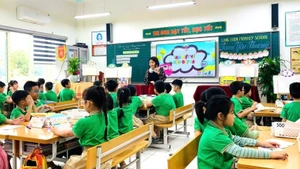Gender equality in general and the prevention and response to gender-based violence in particular are among the issues that the Party, State, Government, and relevant ministries and agencies have constantly given great attention and while being committed to the implementation of solutions. Legally, Vietnam has been active in developing policies and laws to promote gender equality and end violence against women. This is proved through many related important legal documents such as the Constitution, the 2006 Law on Gender Equality, the 2007 Law on the Prevention and Control of Domestic Violence, and the Law on Children (2016).
Many programmes and action plans on preventing and combating gender-based violence have been developed and carried out, such as the National Action Programme on preventing and combating domestic violence until 2020 and the National Action Plan on preventing and combating child violence and abuse during 2020-2025 period.
The Government has issued a series of solutions in terms of institutions, policies, and communications, improvement of awareness and capacity, and research and pilot development of service delivery models to support people suffering from gender-based violence, with many diverse and rich forms. To address different aspects of gender-based violence, Vietnam has adopted inter-sectoral coordination mechanism, one of the solutions highly appreciated for its effectiveness and practical value.
Despite great efforts to prevent and eliminate gender-based violence in Vietnam, reality shows that this work still faces many challenges. The policy and legal system related to gender-based violence prevention is quite sufficient and comprehensive, but many legal documents have yet to provide a definition of gender-based violence.
Meanwhile, regulations on gender-based violence are scattered in many legal documents, making them difficult to handle. The service delivery system still faces many difficulties in terms of facilities, equipment, human resources, and staff skills. Specifically, the coordination among relevant agencies and units is still not truly unified and synchronised, affecting the quality of the support for victims and causing fear among people when needing support.
It is worth mentioning that awareness of gender-based violence is still limited. Most victims of gender-based violence often harbour prejudices, accept silence, and rarely seek help from official services or local authorities.
The elimination of gender-based violence requires the participation, connection, and close coordination of all relevant agencies and organisations at the central and local levels. Functional units need to continue to implement inter-sectoral coordination regulations and replicate this model towards ensuring efforts to prevent, combat, and respond to gender-based violence in a comprehensive and thorough manner. It is also crucial to expand and improve the quality of the support service network for victims of gender-based violence so that the victims can access quality support services in a timely manner no matter where they live or what situation they are in. It is necessary to strengthen propaganda and dissemination of laws on gender-based violence and diversify propaganda forms so that the community can identify acts of violence and promptly prevent and denounce these acts.
















